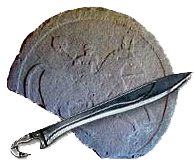Realizada por: maysol
Al Druida: Rexhispaniae
Formulada el martes, 17 de junio de 2008
Número de respuestas: 2
Categoría: Linguistica, onomástica y toponimia
No uses esta información en otros sitios web ni publicaciones, sin el permiso del autor y de Celtiberia.net

Tu único clic no la borarrá, pero contribuirá a que la sabiduría del grupo pueda funcionar correctamente.
¡Hola estimada Maysol!
Siento decirte, que la búsqueda sobre el nombre de la esposa o esposas de Pedro, Duque de Cantabria, es algo infructuoso, debido al hecho de que no existe dentro de las fuentes; documentaciones; o crónicas, caso de la Sebastianens, la Rotense, u otras, donde el nombre de dicha dama o damas, no está. Además, la existencia de Pedro, Duque de Cantabria no es segura al cien por cien, mas está aceptada historiográficamente, aunque ciertamente debatida. Aún así, la pregunta se la traslado al resto de compañeros druidas, sobre ¿Quién se casó con Pedro, Duque de Cantabria? Ahí queda.
Bueno un saludo amiga, y espero haberte aclarado algo. Saludos desde Cádiz.
Rexhispaniae
PEDRO
, son of [ARDABASTO of the Visigoths]. Pedro was the brother of King Ervigio according to Salazar y Castro[34], while the Chronicle of Alfonso III describes his son, Alfonso I King of Asturias, as "of the royal line" without specifying his ancestry[35]. The HistoriaSilense names "Petrus ex Recaredi…Gotorum principis progenie"[36], although Pedro's descent from King Recaredo I cannot be established. It is assumed that this alleged family relationship with the Visigoths is another example of an invention by later genealogists wishing to fill the information gaps left by the primary sources. Duque de Cantabria[37].
m ---. The name of Pedro's wife is not known.
Duque Pedro & his wife had [two] children:
1. ALFONSO([705/10]-757). The Chronicle of Alfonso III names "Alfonso the son of Peter, who was the leader of the Cantabrians and was of the royal line" when recording his arrival in Asturias[38]. The Historia Silense records that "Petrus ex Recaredi…Gotorum principis progenie" had "duos filios…Adefonsum…et Froylam"[39]. His birth date range is estimated based on his having fought alongside his father-in-law, therefore before 737, according to the Chronicle of Alfonso III[40]. Duque de Cantabria. The Chronicle of Alfonso III states that, after the death of Favila (his brother-in-law, in 739), he was elected to succeed as ALFONSO I "el Católico" King of Asturias[41]. He took advantage of instability in the Muslim Government of Andalucía following the Berber rebellion of 741, and of a severe famine in 750, to expand the area of Christian settlements to the north of the Douro river, a list of the towns he conquered being set out in the Chronicle of Alfonso III[42]. He established fortifications along the central Cordillera at Coimbra, Coria, Talavera, Madrid, Guadalajara and Medinaceli, fixing the northern frontier of the Muslim occupation for the next three centuries. On the other hand, Muslim incursion was more successful along the eastern frontier, with settlements established as far as the Pyrenees, including Pamplona, Tudela, Huesca, Girona and even Narbonne until it was captured by Pépin King of the Franks in [759][43]. The Chronicle of Alfonso III states that King Alfonso "lived as king for eighteen years and died a natural death"[44]. The Chronicon Compostellani records that “Alfonsus” reigned 19 years, one month and one day[45]. m (before 737) ERMESINDA de Asturias, daughter of PELAYO King of Asturias & his wife [Gaudiosa ---]. The Chronicon Albeldense records that “Bermisindam, Pelagii filiam” married “Adefonsus…Petri, Cantabriæ ducis filius” who succeeded King Favila[46]. The Chronicle of Alfonso III names "the daughter of PelayoErmesinda" when recording her marriage to "Alfonso the son of Peter"[47]. Her birth date range is estimated from the birth of her first known child in [740]. Her marriage date is deduced from the Chronicle of Alfonso III recording that Alfonso "enjoyed many victories alongside his father-in-law"[48]. Mistress (1): ---. The name of King Alfonso's mistress is unknown. She is named Sisalda in Béthencourt[49], but Barrau-Dihigo highlights that she is not named in any near contemporary source[50].
[34] Salazar Casa de Lara, p. 453.
[35] Chronicle of AlfonsoIII, 11, p. 169.
[36] Pérez de Urbel, J. and González Ruiz-Zorrilla, A. (eds.) (1959) Historia Silense (Madrid), (“Historia Silense (Pérez)”), 26, p. 136.
[37] ChronicaAlbeldense, 52, quoted in Barrau-Dihigo (1989), p. 127 footnote 89.
[38] Chronicle of AlfonsoIII, 11, p. 169.
[39] Historia Silense (Pérez), 26, p. 136.
[40] Chronicle of AlfonsoIII, 11, p. 169.
[41] Chronicle of AlfonsoIII, 13, p. 170.
[42] Chronicle of AlfonsoIII, 13, p. 170.
[43] Kennedy, H. (1996) Muslim Spain and Portugal (Longman), p. 29.
[44] Chronicle of AlfonsoIII, 14, p. 170.
[45] Chronicon Compostellani, España Sagrada XXIII, p. 325.
[46] Chronicon Albeldense 52, Patrologia Latina Vol. 129, col. 1137A.
[47] Chronicle of AlfonsoIII, 11, p. 169
[48] Chronicle of AlfonsoIII, p. 169.
[49] Béthencourt, Vol. I, p. 167.
[50] Barrau-Dihigo (1989), p. 244.
Hay 2 comentarios.
1